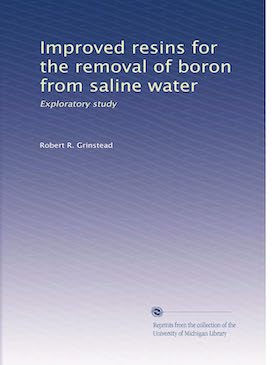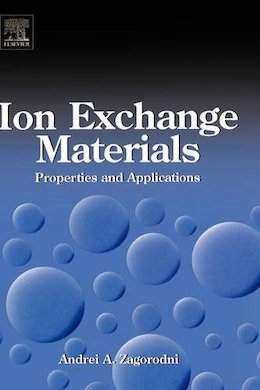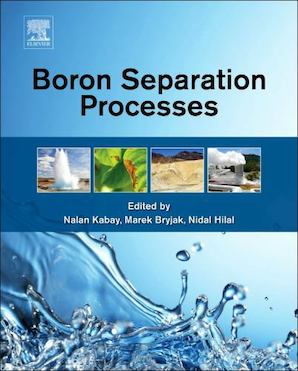
-----
Boron Removal from Waste Water by Ion Exchange
Quickstart:
Most readers with boron treatment experience feel that ion exchange is the only reliable way to get boron to really low concentration, but it requires specialized resins with very little holding capacity and is very expensive.
So reduction at the source, or pretreatment in some manner is usually recommended.
This thread focuses on the ion exchange method, and thread 02/42 addresses those alternate ideas which may not achieve super-low concentration but may be good enough, or may be worth applying on the waste stream before a final DI polishing.
Q. Anyone out there have a process (or an idea!) for removing boron from wastewater generated from Alodine process? The boron from sodium fluoborate which is present in our chemistry. Our local limit for discharge is 5 ppm and the concentrations in our raw wastewater are around 20 to 30 ppm.
Dan D. [last name deleted for privacy by Editor]Tucson, Arizona
1999
A. There are boron-selective ion exchange resins. I don't have the technical information readily available as I write this but I will get it together for anyone who needs to know more.
You can also put in a total recycle deionization system (non-selective cation and anion resins) and return the water back to the process. The fluoborates will be removed along with all the other ions in the process. Canister rental and off-site regeneration is preferred to on-site regeneration when you have a discharge limitation. You get rid of the discharge problem by letting someone else do the regeneration. Unfortunately this also costs more.

Bill Vins
microwave & cable assemblies - Mesa (what a place-a), Arizona
⇦ Tip: Readers want to learn from your situation;
so some readers skip abstract questions.
Q. I need to know more about boron removal. Please assist me. Is there any polymer that can treat the boron. Please provide me the P&ID; for the process if there is any.
Regards,
Engineered Management System - Malaysia
2001
A. Boron can be tricky to remove, especially if you do not know what form it is in. It can be as boron, as boric acid, as borate, or many others. There are several methods to remove boron from waste water, and given your location, I would say that you are likely getting hit with Malaysia B standards, right? If thats the case, then you should look at a capture, concentrate, and haul technology that will get you to the very low standards reliably. I am not aware of any polymers that have successfully been implemented to remove boron. There are specific ion exchange resins that we have used to remove it, and they fair well as long as they are taken care of and the pre-treatment is completed correctly.

Tom Baker
wastewater treatment specialist - Warminster, Pennsylvania
A. Majority of what you see will be borate ions. Try contacting your local Rohm & Haas ion exchange resin dealer and ask for XE-243 or it's latest equivalent. You can also use a product from Purolite, S-108. These resins regenerate with sulfuric acid and allow you to crystallize boric acid in high acid concentrations, so no haul off is necessary, and the boric acid can be reused in the process where it came from. Hope this helps.
Juzer Jangbarwalawastewater treatment supplier - Santa fe Springs, California USA
A. I would not recommend the reuse of boric acid obtained from regenerated ion exchange resin. While it is certainly a novel method of removing borate, the purity of the boric acid is so low as compared to even a moderate purity of technical grade boric acid that you would be looking for trouble in your plating quality. Same goes for metals and metal solutions - they don't even meet the most liberal purity standards required by platers.
The regeneration is a two step process, and requires sodium hydroxide
[affil link] to condition the resin to accept borate. If you want to pursue that method, be prepared to have an extra waste stream to treat that is essentially just another cost center.

Tom Baker
wastewater treatment specialist - Warminster, Pennsylvania
Q. I am interested in the technology, capital cost as well as average annual cost for reducing Boron in an industrial wastewater from 12 mg/l to a level below 1.0 mg/l and a flow rate of 100,000 gallons per day.
Any information would be appreciated.
Thank You,
William M., PE [last name deleted for privacy by Editor]- Rancho Santa Margarita, California
2001
A. You can achieve this removal by some specialty ion exchange resins with the N-methylglucamine functional group. Capacity will vary according to background salts, and is most dependent on flow rate. Resins can be regenerated by sulfuric acid. Hope this helps.
Juzer Jangbarwalawastewater treatment systems - Santa Fe Springs, California
A. Ion exchange will work, using the selective resins mentioned in a previous response, but the capacity is very low: approximately 2 ounces of boron per cubic foot of resin at exhaustion. It may be your best method, but it is a rather expensive resin, and you would exhaust 80-120 cubic feet of resin per day.
One of the problems will be what to do with the large waste volume that this would generate. There are a couple of references that suggest that the sulfuric acid can be reused several times and saturated with crystallization of the boric acid, but the last time I tried to find anyone doing this, I was unsuccessful.
If this is wastewater, another possibility is to recycle this water, by Ion exchange if the Total Dissolved Solids concentration is low, or by HERO reverse osmosis if the TDS concentration is high. Conventional RO systems will not have good boron rejection, but at a high operating pH, the rejection is > 90%. You would still have a boron containing waste, but in a much more concentrated and lower volume.
Lyle Kirmanconsultant - Cleveland Heights, Ohio
Multiple threads merged: please forgive chronology errors and repetition 🙂
Q. Please I need your information of the removal of boron a 0.75 ppm
Any information would be appreciated!
Fabiola M. [last name deleted for privacy by Editor]- Los Andes, Chile
2001
|
|
huh? Can anybody enlighten me regarding why regulators are looking for such low boron levels? I'm not a medical expert nor an epidemiologist, but I have spent some time trying to find the potential bad consequences, and everywhere I look I see higher levels than this being acceptable in drinking water; and lots of natural water not being this low in boron; and these levels seem below the level of negligible effect. I don't want to be reactionary or luddite, but it seems a waste of resources to manufacture then landfill so much man-made resin only to very temporarily reduce such a prevalent element as boron to unnaturally low levels -- what is it that I am missing please?  Ted Mooney, P.E. Striving to live Aloha finishing.com - Pine Beach, New Jersey Ted can be retained for immediate answers or long term project help |
Q. We are interested in cost effective removal of boron from water at levels of around 5 ppm. Does anyone have any advice or information?
Anna M. [last name deleted for privacy by Editor]- Fife, UK
2001
A. Hi,
For boron removal there are some methods.
E.g., there are selective ion exchange resins (such as [brand names deleted by editor]).
Ion exchange is the method of choice, when you don't have to remove other components. Otherwise membrane processes like Nanofiltration or reverse osmosis might be helpful, too.
Wolfgang Neubrand- Mondsee Austria
A. Boron removal can be achieved by commercially available ion exchange resins with the N-Methylglucamine functional group (a couple of products I know of are [brand names deleted by editor]). Though a weak base anion backbone, resin is regenerated with sulfuric acid, and boric acid is recovered as a by-product by crystallization. Hope this helps.
Juzer Jangbarwala- Santa Fe Springs, California USA
A. [brand name deleted by editor] resin can remove the boron.
Sally Quresin supplier - Xi;an China
March 18, 2015
Ed. note: If readers wish to use IX resin for boron removal, please talk to vendors about resins as described by Juzer. Sorry, we can't print brand names ( huh? why?)
Q. I am looking for detailed information about Boron removal from waste water -- specifically, the borates produced from Borax.
We are thinking along the lines of ion exchange with [brand name] resin to get the level below 10 ppm. All my research so far points to this as the only viable, albeit expensive option. My questions are:
1) what do you do with the boric acid crystals that are precipitated from the regeneration rinse water?
2) how much does it cost to implement ion exchange filter?
- Kingsville, Ontario, Canada
2002
Ed. note: We deleted the brand name that Paul mentioned ( huh? why?); it prompted people to send in page-long sales spiels of why their resin was better than the one he mentioned 🙂
by Robert R. Grinstead

on Amazon
or AbeBooks
(affil link)
A. Both boron selective medias, and also close-looping the boron containing flow in order to remove boron from discharges can be done. There are boron-selective resins that can be used to remove boron to < 1 mg/L, but they are very expensive and have a low capacity.
If the boron is > 25% of the total anion present, then a strong base resin may be a better choice.
It is difficult to crystallize the boric acid as you suggest, because it first needs to be supersaturated. The solubility of boric acid vs. temperature would appear to make this easy, but the low capacity of the boron-selective resin makes this difficult.
Lyle Kirmanconsultant - Cleveland Heights, Ohio
A. Selective resins for boron removal are available. They are extremely efficient and produce a residual boron level of a few ppb in the treated water.
They are applicable for drinking water treatment as well as industrial applications.
François de Dardel- Paris, France
2003
Q. Boron discharge std, 4 mg/ml Std B is too strict. Malaysian std B for boron is 4 mg/ml. My waste water can only come down to 30 mg/ml. I have tried many tricks and waste water consultant however, non of it is successful. Can you advise if the 4 mg/ml is an impossible standard, that it is impossible to reach? What is the Boron discharge level for US, UK or EU?
Thank you,
Tan, SF- Penang, Malaysia
2003
A. There are very few ways to remove boron from water to low concentrations. If you cannot find an alternative chemistry that does not contain boron, one way to remove boron is by a selective ion exchange resin with n-glucamine functional groups. This resin can remove boron to less than 1 mg/l. However, the resin is very expensive and has a low capacity before it becomes exhausted and must be regenerated.
In most cases, it is preferable to go to the source of the boron, and put in some kind of closed-loop recycling system. Even if there is a waste from this system, it will be a small volume with a high concentration, so even if you can only treat it down to 30 mg/l, there may be enough other dilution water to allow you to meet the 4 mg/l limit.
There are no USEPA limits for boron, but there are State and local limits in many parts of the country. Some of these are as low as 1 mg/l.
Good luck in finding a solution to your problem.
Lyle Kirmanconsultant - Cleveland Heights, Ohio
Unable to meet Boron effluent limit
Can you help us to find the way about 1000 mg/l b as boric acid in the waste water?
And the limit is 1 mg/l only.
We can even invite your engineer come here and teach everything.
We are an environmental engineering company in Taiwan.
Best wishes
Wang Chuan Hsin- Taiwan
2005
Q. New regulations for waste water set a limits for boron to less then 1.5 mgr/liter.
We currently plate bright nickel in our electroplating on plastics plant.
(the boron comes from the boric acid in the Ni bath).
Is there any way to cope with this regulation ?
Thank you for any information.
plating on plastics - Tel Aviv, Israel
2006
A. This is a difficult problem because, as far as I know, there is no effective way to precipitate boric acid to this concentration or below it.
There are very expensive Ion Exchange resins that can selectively remove boron from wastewater. These have very low capacity, but can reduce boron to < 1 mg/L.
Your best course of action is to minimize this boron containing waste flow at the source, before it mixes with other rinses. My advice is to recycle your nickel rinses using a combination of dragout recovery rinses and supplemental evaporation. This also concentrates impurities in the bath, so it is not a perfect solution.
Another potential solution is to use the dragout recovery method for 80-90% recovery, and then to recycle the final one or two rinses with Ion Exchange. The anion resin regenerations will contain the borates, so they must be hauled off site for disposal somewhere where they don't have the same boron limit.
consultant - Cleveland Heights, Ohio
Q, A, or Comment on THIS thread -or- Start a NEW Thread

